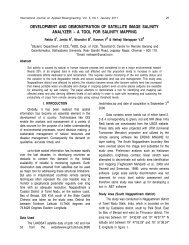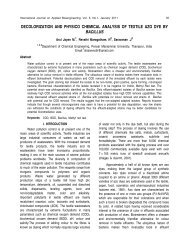Download Full Paper - Sathyabama University
Download Full Paper - Sathyabama University
Download Full Paper - Sathyabama University
You also want an ePaper? Increase the reach of your titles
YUMPU automatically turns print PDFs into web optimized ePapers that Google loves.
20 Vijayaraghavan et al : Biosorption of Acid red 88 onto Azolla pinnata: ....<br />
time. Fig .6, shows that highest uptake and high<br />
percentage dye removal are obtained at the highest dye<br />
concentration. Also more positive and steep breakthrough<br />
curve was obtained for 100 mg dye/L. The driving force for<br />
biosorption is the concentration difference between the<br />
dye on the biosorbent and the dye in the solution [22]. Thus<br />
the high driving force due to the high AR88 concentration<br />
resulted in better column performance. Comparison of<br />
experimentally determined and Thomas model predicted<br />
breakthrough curves are shown in Figs. 4, 5 and 6. As bed<br />
height increased, the values of Q increased and the<br />
0<br />
values of k decreased. The bed capacity Q decreased<br />
Th 0<br />
and Thomas constant k increased with increasing flow<br />
Th<br />
rate. In general, good fits were obtained in all cases with<br />
correlationcoefficientsrangingfrom0.992to0.999forAR88.<br />
C/C0<br />
1<br />
0.75<br />
0.5<br />
0.25<br />
0<br />
Initial Dye Concentration<br />
0 20 40 60 80<br />
Time (h)<br />
Fig .6 Breakthrough curves for AR88 biosorption onto A. pinnata biomass at<br />
different dye concentrations (bed height = 25cm, flow rate = 5mL/min, pH =<br />
3). Initial AR88 concentrations: ( ) 50 mg/L; ( ) 75 mg/L; (?) 100 mg/L. (------)<br />
Predicted from Thomas model.<br />
IV. SUMMARY AND CONCLUSION<br />
The present study investigated the following<br />
features of dye biosorption on deactivated macro blue<br />
green fresh water alga A. pinnata in a batch reactor and in<br />
a packed bed column. Batch experiments provided<br />
fundamental information regarding optimum pH and<br />
maximum dye uptake. Langmuir and Toth model<br />
isotherms fit well with experimental data. Column<br />
experiments were performed in a packed column, as it<br />
makes the best use of the concentration difference known<br />
to be a driving force for adsorption. Thus, A. pinnata<br />
possesses all intrinsic characteristics to be employed for<br />
the treatment ofAcid red 88 bearing industrial effluents.<br />
REFERENCES<br />
[1] K.R. Ramakrishna and T. Viraraghavan, Dye removal<br />
using low cost adsorbents. Wat. Sci. Tech., 36 (1997)<br />
189-196.<br />
[2] Z. Aksu, Reactive dye bioaccumulation by<br />
Saccharomyces cerevisiae. Proc. Biochem., 38<br />
(2003) 1437-1444.<br />
[3] W.L. Chao and S.L. Lee, Decolorization of azo dyes<br />
by three white rot fungi: influence of carbon source.<br />
World J. Microbial. Biotechnol., 10 (1994) 556-559.<br />
[4] R.H.S.F. Vieira, B. Volesky, Biosorption: a solution to<br />
pollution?, Int. Microbial., 3 (2000) 17-24.<br />
[5] S. Venkatamohan, N. chandrasekhar Rao Y, K.<br />
Krishna prasad and J. Karthikeyan, Treatment of<br />
stimulated reactive yellow 22 (azo) dye effluents<br />
using spirogyra species. Waste management, 22<br />
(2002) 575-582.<br />
[6] Z. Aksu, Application of biosorption for the removal of<br />
organic pollutants a review. Proc. Biochem., 40<br />
(2004) 997-1026.<br />
[7] T.L. Hu, Removal of reactive dyes from aqueous<br />
solution by different bacterial genera. Wat. Sci.<br />
Technol., 34 (1996) 89-95.<br />
[8] Y. Fu and T. Viraraghavan, Removal of C.I. acid blue<br />
29 from an aqueous solution by Aspergillus niger.<br />
AATCC Mag., 1 (2001) 36-40.<br />
[9] Z. Aksu, and S. Tezer, Biosorption of reactive dyes on<br />
the green alga Chlorella vulgaris. Proc. Biochem., 40<br />
(2005) 1347-1361.<br />
[10] T.V.N. Padmesh, K. Vijayaraghavan, G. Sekaran and<br />
M. Velan, Batch and column studies on biosorption of<br />
acid dyes on fresh water macro alga Azolla<br />
filiculoides. J. Hazard. Mat., 125 (2005) 121-129.<br />
[11] B. Volesky, J. Weber, J.M. Park, Continuous-flow<br />
metal biosorption in a regenerable Sargassum<br />
column, Wat. Res., 37 (2003) 297-306.<br />
[12] Z. Aksu, F. Gönen, Biosorption of phenol by<br />
immobilized activated sludge in a continuous packed<br />
bed: prediction of breakthrough curves, Proc.<br />
Biochem., 39 (2003) 599-613.<br />
[13] G. Yan and T. Viraraghavan, Heavy metal removal in<br />
a biosorption column by immobilized M. rouxii<br />
biomass. Biores. Technol., 78 (2001) 243-249.<br />
[14] DCK. Ko, JF. Porter and G. McKay, Optimised<br />
correlations for the fixed-bed adsorption of metal ions<br />
on bone char. Chem. Eng.<br />
5829.<br />
Sci., 55 (2000) 5819-<br />
Dr K Vijayaragavan is Post<br />
Doctorate in Environmental<br />
Biotechnology from Chonbuk<br />
National <strong>University</strong>, South Korea. He<br />
is currently working for National<br />
<strong>University</strong> of Singapore in the<br />
Department of Environmental<br />
Science and Engineering. His<br />
contributions in the field of<br />
Environmental Biotechnology is immense.









